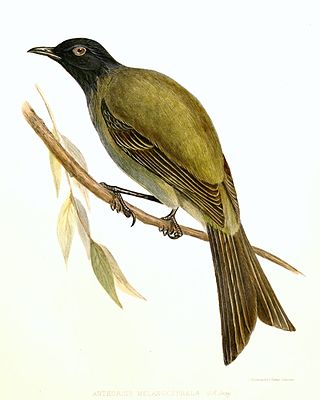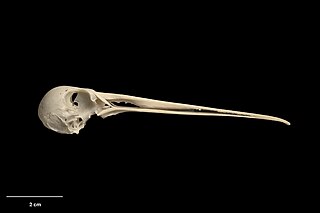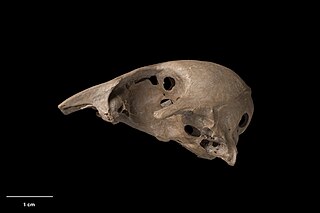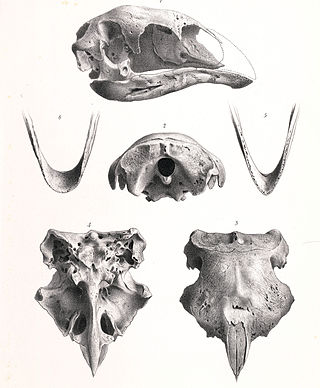
The New Zealand wrens are a family (Acanthisittidae) of tiny passerines endemic to New Zealand. They were represented by seven Holocene species in four or five genera, although only two species in two genera survive today. They are understood to form a distinct lineage within the passerines, but authorities differ on their assignment to the oscines or suboscines. More recent studies suggest that they form a third, most ancient, suborder Acanthisitti and have no living close relatives at all. They are called "wrens" because of similarities in appearance and behaviour to the true wrens (Troglodytidae) but are not members of that family.

The bushwren, also known as the mātuhituhi in the Māori language, was a very small and almost flightless bird that was endemic to New Zealand. It had three subspecies on each of the major islands of New Zealand, the North Island, South Island, and Stewart Island / Rakiura and nearby smaller islands. The species disappeared gradually after the introduction of invasive mammalian predators, last being seen on the North Island in 1955 and the South Island in 1968. Attempts were made to save the remaining population on small islands off Stewart Island, but they ultimately failed with the death of the last remaining known birds in 1972.

Lyall's wren or the Stephens Island wren was a small, flightless passerine belonging to the family Acanthisittidae, the New Zealand wrens. Now extinct, it was once found throughout New Zealand, but when it came to the attention of scientists in 1894, its last refuge was Stephens Island in Cook Strait. Often claimed to be a species driven extinct by a single creature, the wren in fact fell victim to the island's numerous feral cats. The wren was described almost simultaneously by both Walter Rothschild and Walter Buller. It became extinct shortly thereafter.

The piopio or turnagras are an extinct genus of passerine birds in the family Oriolidae, that were endemic to New Zealand. Sometimes described as New Zealand thrushes, the piopio had only a coincidental, passing resemblance to the thrush family.

The New Zealand raven was native to New Zealand, but has been extinct since the 16th century. There were three subspecies: the North Island raven, South Island raven, and Chatham raven from the Chatham Islands.
The Tasman starling was described in 1836 by John Gould as a species which occurred on both Norfolk Island and Lord Howe Island. In 1928 Australian ornithologist Gregory Mathews recognized that the plumage of the race from Lord Howe Island was much browner and more greyish than the plumage of the Norfolk Island race and split the species into two forms, the Norfolk starling, and the Lord Howe starling. Both subspecies are now extinct, thus so the species.

The austral snipes, also known as the New Zealand snipes or tutukiwi, are a genus, Coenocorypha, of tiny birds in the sandpiper family, which are now only found on New Zealand's outlying islands. There are currently three living species and six known extinct species, with the Subantarctic snipe having three subspecies, including the Campbell Island snipe discovered as recently as 1997. The genus was once distributed from Fiji, New Caledonia and Norfolk Island, across New Zealand and southwards into New Zealand's subantarctic islands, but predation by introduced species, especially rats, has drastically reduced their range.

Finsch's duck was a large terrestrial species of duck formerly endemic to New Zealand. The species was possibly once the most common duck in New Zealand, a supposition based on the frequency of its fossils in bone deposits.

The New Zealand bittern is an extinct and enigmatic species of heron in the family Ardeidae. It was endemic to New Zealand and was last recorded alive in the 1890s.

The Chatham bellbird or kōmako is an extinct species of bird in the family Meliphagidae. It was endemic to the Chatham Islands.

Xenicus is a genus of birds in the family Acanthisittidae. It contains New Zealand wrens.

Forbes's snipe is an extinct species of New Zealand snipe formerly endemic to the Chatham Islands. It was the larger of two species found there, the smaller being the surviving Chatham snipe. It was never seen alive by scientists and is known only from fossil material collected on the islands. Why it became extinct while its smaller relative survived is a mystery, as is the exact timing of its extinction, although it may have survived, unnoticed, until the 15th century.

The New Zealand stiff-tailed duck is an extinct duck species from New Zealand which is known only from subfossil remains. It was first described as a distinct species by Trevor H. Worthy in 2005.
Scarlett's duck is an extinct duck species from New Zealand which was closely related to the Australian pink-eared duck. The scientific name commemorates the late New Zealand ornithologist and palaeontologist Ron Scarlett who discovered the holotype in 1941. However, previously undescribed bones of the species found in 1903 were rediscovered in the Otago Museum in 1998. At least 32 fossil remains from deposits in Pyramid Valley, at Ngāpara in the South Island, and at Lake Poukawa in the North Island are in museum collections.

The broad-billed moa, stout-legged moa or coastal moa is an extinct species of moa that was endemic to New Zealand.

The New Zealand goose is a bird of the extinct genus Cnemiornis of the family Anatidae, subfamily Anserinae. The genus, endemic to New Zealand, consisted of two species: the North Island goose, C. gracilis and the South Island goose C. calcitrans.
Scarlett's shearwater is an extinct species of seabird in the petrel family Procellariidae. Its common name commemorates New Zealand palaeontologist Ron Scarlett, who recognised the bird's subfossil remains represented a distinct species.

Anas chathamica, the Chatham duck or Chatham Island duck is an extinct species of duck which once lived in New Zealand's Chatham Islands in the south-west Pacific Ocean. It likely became extinct in about the 16th century because of hunting by humans.

Stout-legged wren is a common name referring to two species of extinct New Zealand wrens: the North Island stout-legged wren or Grant-Mackie's wren, and the South Island stout-legged wren or Yaldwyn's wren. These small birds were endemic to New Zealand and were previously included in the genus Pachyplichas.
















